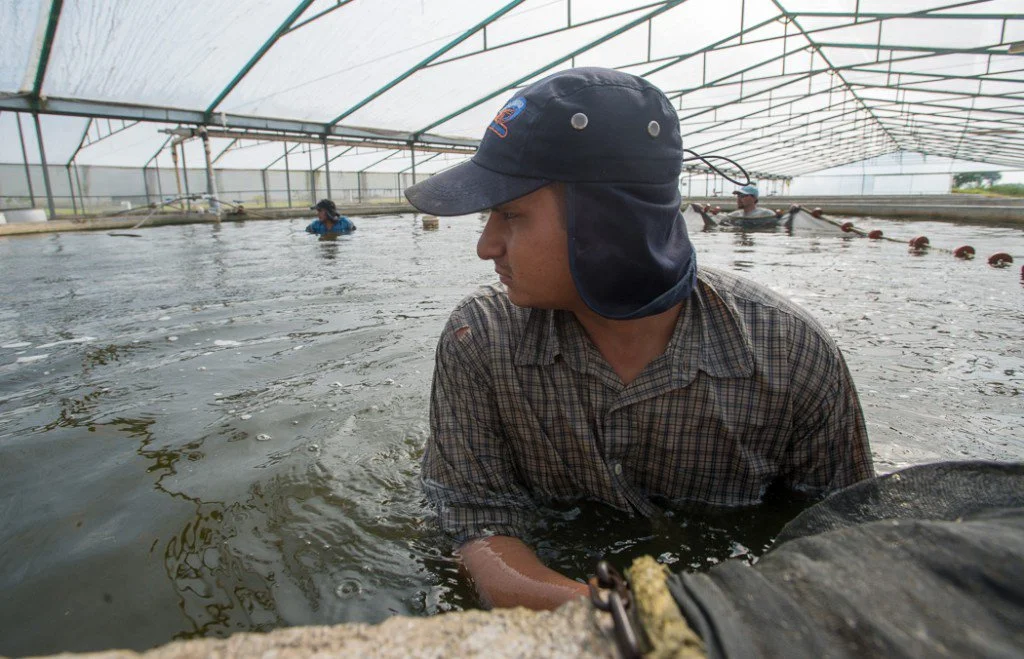Farmers in Mexico value U.S. soymeal

The United States Soybean Export Council (USSEC) is constantly looking for new uses for soy internationally and this week members of Qualified State Soybean Boards (QSSB) were able to see firsthand how markets are growing in Mexico.
Aquaculture has been a buzz worked in the United States lately but it is a practice that has been consuming U.S. soy for many years. Countries like Costa Rica, Panama, Ecuador and Mexico import large amounts of soymeal to grow tilapia and shrimp.
A worker pulls a net to capture fish in an aquaculture tank in Mexico.
Molina Farms, in the town of Jamay near Lake Chapalais, is a family farm doing just that. By importing high quality soybean grain from the U.S., they are creating large profit margins for their fresh tilapia sales and fingerling sales.
Fingerling sales is the process of selling the tilapia when they are four grams to other area producers to feed out. Molina farms are concentrating on the breeding and genetics of the tilapia to gain a premium from other farmers who don't have the facilities or genetics to start tilapia from the beginning.
The Molina Family Farm also sells fresh fish from their farm. The fresh fish sales are offered directly to consumers in the region. To keep profit margins as large as possible, Alfredo Molina invests in high quality U.S. soymeal for his rations and is also using cutting edge technology for the area.
"We spend about $1.30 per kilo of tilapia in production costs and can sell the live fish for about $4.00 a fish," Molina said, speaking through an interpreter.
Molina showed the group the finishing ponds for the tilapia where about 20,000 fish are grown per 10 foot pond. When the tilapia is ready for market it weighs between 500-600 grams or just over a pound. They use a ration of soybean made up of 40 to 50 percent soymeal. Molina said that U.S. soymeal is preferred, but due to higher prices last year, they had to import from other South American Countries.
The Biofloc system aerates the water, keeping the algae and nutrients from settling on the bottom. The system allows the fish to feed off the remaining nutrients in the water and helps build their immunity. Because of the ecological system farmers need to make sure increased algae doesn't starve the fish of oxygen. Computer systems linked to a recently installed Wi-Fi network monitor oxygen levels and can automatically adjust levels as necessary. In the past, aquaculture farmers would employee a poly fish culture, having tilapia paired in rotation with catfish or shrimp, but that cut down on production of the valuable tilapia. According to Molina, Bioflock system helps him to raise a higher quality fish in less space while increasing the growing cycle.
"The Biofloc system is rough, but we need to master it," he said.
To fill market demand Molina is looking at raising shrimp at his farm, too. He told the group gathered that his working relationship with USSEC will help him to manage the new enterprise.
“It will be trial and error at first but USSEC offers excellent information about feed rations and what other farmers are doing to be successful,”Molina said.
Heather Lilienthal, director of producer services at the Iowa Soybean Association (ISA), attended the USSEC tour in Mexico. She said seeing the uses of soy imported from the U.S. was fascinating.
"This was my first opportunity to visit an aquaculture operation and learn how this family is using soy in its feed," she said. "As they expand their operation and adapt to new technology, it reminded me of Iowa farms doing the same thing. Everyone is striving to be more efficient in order to meet growing demand for their products."
For more than two decades, Joseph L. Murphy has had the pleasure of meeting and connecting with people from all walks of life through photography. He has photographed presidents and heads of state, traversed the winding alleyways of the Fes Medina in Morocco, photographed the sprawling countryside and people that make up Argentina and covered events that have defined the U.S. Most recently, Murphy’s travels have taken him to Cambodia, Mexico, China, Vietnam and Ecuador.
He has spent the past 20 years specializing in agriculture photography for multiple organizations, publications and marketing projects.
A graduate of the University of Iowa, Murphy determined at an early age that his love of photography would shape his vision for life.
